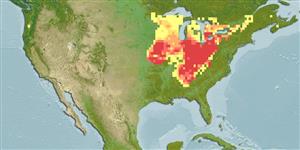Classification / Names
Common names | Synonyms | Catalog of Fishes (gen., sp.) | ITIS | CoL | WoRMS | Cloffa
Actinopterygii (ray-finned fishes) >
Perciformes (Perch-likes) >
Percidae (Perches) > Etheostomatinae
Etymology: Etheostoma: Greek, etheo = to strain + Greek, stoma = mouth; Rafinesque said "various mouths", but Jordan and Evermann suggest the name might have been intended as "Heterostoma (Ref. 45335); blennioides: blennioides meaning blenny-like (Ref. 10294). More on author: Rafinesque.
Environment / Climate / Range
Ecology
Freshwater; benthopelagic. Temperate; 4°C - 18°C (Ref. 2059), preferred ?; 43°N - 34°N
North America: Great Lakes and Mississippi River basins from New York and Maryland to eastern Kansas and Oklahoma in the USA, and from Ontario in Canada south to Georgia, Alabama and Arkansas in the USA; and Atlantic Slope in Mohawk, Susquehanna and Potomac drainages in New York and Virginia, USA.
Size / Weight / Age
Maturity: Lm ? range ? - ? cm
Max length : 17.0 cm TL male/unsexed; (Ref. 5723); common length : 5.5 cm TL male/unsexed; (Ref. 12193); max. reported age: 5 years (Ref. 12193)
Inhabit rocky riffles of creeks and small to medium rivers, and shores of large lakes (Ref. 5723, 10294). Juveniles feed on midge larvae and microcrustaceans; adults consume midge larvae, blackfly larvae, and other immature aquatic insects, primarily mayflies and caddisflies (Ref. 10294). Distinct pairing during breeding (Ref. 36980). Eggs are found attached to the substrate unguarded (Ref. 7043).
Distinct pairing during breeding (Ref. 36980). Eggs are found attached to the substrate abandoned (Ref. 7043).
Page, L.M. and B.M. Burr, 1991. A field guide to freshwater fishes of North America north of Mexico. Houghton Mifflin Company, Boston. 432 p. (Ref. 5723)
IUCN Red List Status (Ref. 115185)
CITES (Ref. 94142)
Not Evaluated
Threat to humans
Harmless
Human uses
More information
ReferencesAquacultureAquaculture profileStrainsGeneticsAllele frequenciesHeritabilityDiseasesProcessingMass conversion
Tools
Special reports
Download XML
Internet sources
